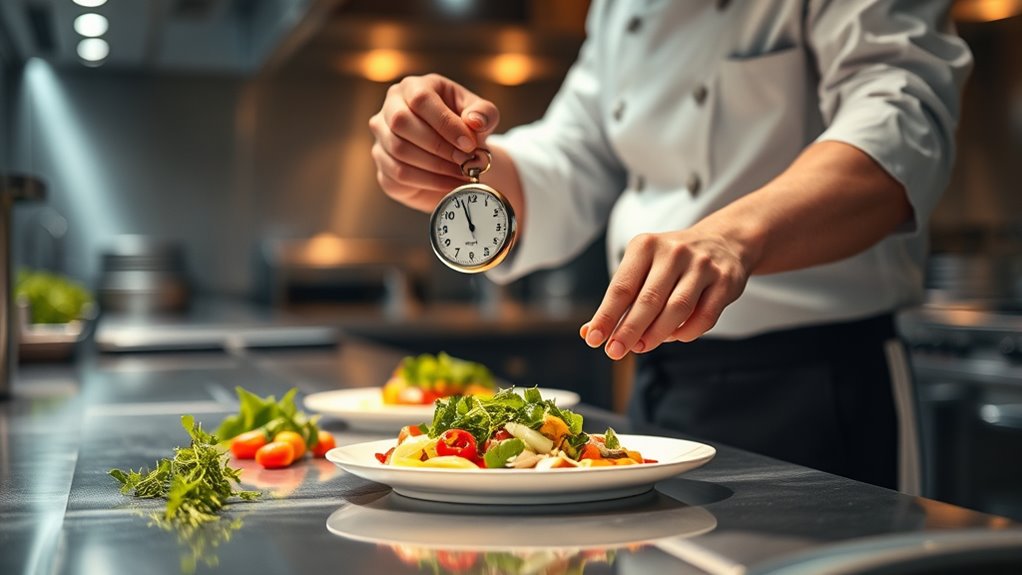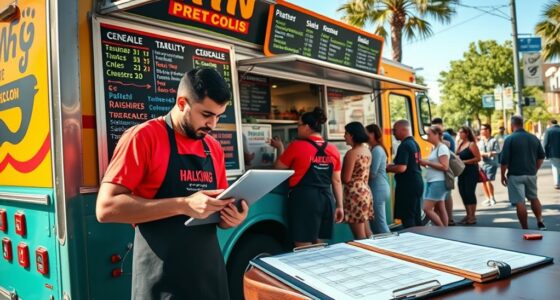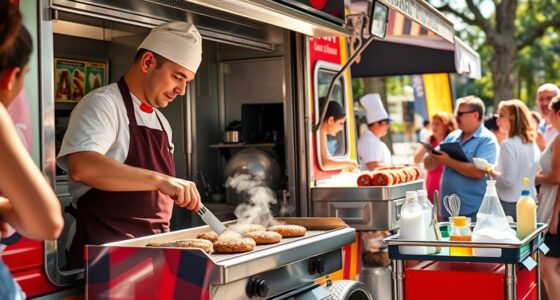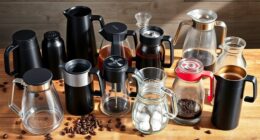Balancing prep time with service time is key to running a smooth restaurant. You should plan prep based on reservation data, peak hours, and ingredient availability. Proper scheduling guarantees your staff is prepared without overloading during busy periods. Managing inventory helps avoid waste and shortages, while coordinated shifts keep workflow steady. If you want to discover effective strategies to optimize your operations, keep exploring how to fine-tune these elements.
Key Takeaways
- Schedule prep tasks during off-peak hours to ensure readiness without disrupting service flow.
- Use inventory data to accurately determine prep quantities, avoiding over- or under-prepping.
- Allocate staff shifts strategically based on demand forecasts to maintain efficiency during peak times.
- Complete as much prep as possible before service begins to minimize delays and streamline customer experience.
- Coordinate between kitchen and front-of-house teams to synchronize prep with service demands effectively.
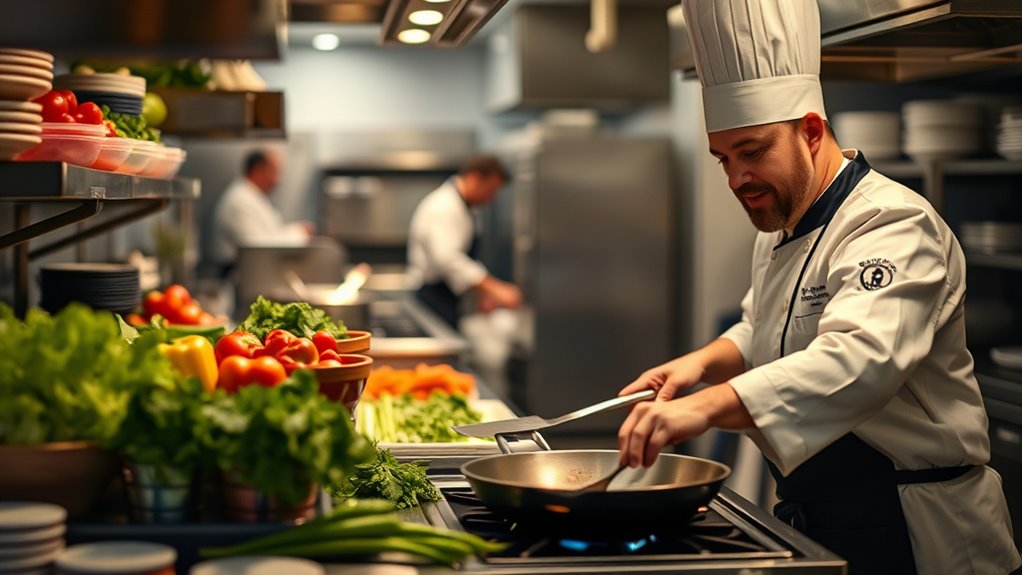
Balancing prep and service time is essential for ensuring a smooth and efficient restaurant operation. When you manage this balance well, you create a seamless experience for your guests and reduce stress for your staff. A crucial part of this process involves effective inventory management, which helps you determine exactly how much to prep and when. By keeping a close eye on stock levels, you avoid over-prepping, which leads to waste, or under-prepping, which results in delays and unhappy customers. Accurate inventory management ensures that you have the right ingredients on hand at the right times, allowing your kitchen to operate smoothly during peak hours without scrambling for supplies.
Alongside inventory management, staff scheduling plays a vital role in balancing prep and service time. When your team is scheduled appropriately, you ensure that there are enough hands in the kitchen and front of house to handle busy periods without feeling overwhelmed. Proper staff scheduling aligns your labor force with anticipated demand, allowing some team members to focus on prep while others handle service. This coordination prevents bottlenecks and keeps the workflow steady. For example, scheduling more prep staff before a busy dinner shift means your kitchen can start service with everything ready, reducing delays and streamlining the process.
You also need to consider how shifts are structured. If you overload your evening staff with prep tasks, they might be caught up when service begins, leading to a backlog. Conversely, if your team isn’t scheduled to handle peak times, service can slow down, and customers might wait longer than they should. By planning your staff schedule based on historical data and upcoming reservations, you can optimize coverage. This proactive approach ensures that prep work is completed in advance and your team is energized and ready to deliver excellent service when it counts.
Furthermore, integrating inventory management with staff scheduling creates a more cohesive operation. When you know your inventory levels and expected demand, you can better plan staffing needs. For instance, if sales forecasts predict a busy weekend, you can schedule extra staff to handle increased prep and service loads. This synchronization prevents both shortages and excess labor, which can be costly. It also encourages your team to work efficiently, knowing their tasks are well-organized and supported by accurate data. Additionally, implementing proper communication between departments ensures everyone stays informed about inventory and scheduling changes, enhancing overall efficiency.
Frequently Asked Questions
How Can Technology Improve Timing Efficiency?
Technology improves timing efficiency through AI integration and real-time analytics, allowing you to monitor operations continuously. AI helps predict busy periods and optimize staff schedules, reducing wait times. Real-time analytics provide instant data on service flow, so you can make quick adjustments. By leveraging these tools, you guarantee smoother service, better customer experience, and more efficient use of prep and service time, ultimately maximizing your overall productivity.
What Are Common Signs of Over-Prepping?
You often over-prep when you notice excess inventory, which indicates poor inventory management. If ingredients go unused or spoil, it’s a sign you’re prepping too much. Complex menu items also lead to over-prepping, as you might prepare for dishes that aren’t ordered frequently. To avoid this, streamline your menu and improve inventory control, ensuring you prep only what’s needed for your current demand, saving time and reducing waste.
How Does Customer Flow Affect Prep Timing?
Customer flow acts like a river, shaping how you time your prep work during peak hours. When flow increases, you need to speed up prep to keep up with demand, but during quieter times, you can slow down and prep more thoroughly. Monitoring customer flow helps you adjust your prep timing, ensuring you’re ready without over-prepping, so your service remains smooth and efficient throughout busy and slow periods.
Are There Industry Standards for Optimal Prep Time?
Industry standards for ideal prep time vary based on your kitchen layout and inventory management. Typically, efficient kitchens aim for prep times around 15-30 minutes for standard dishes, ensuring quick service without sacrificing quality. You should regularly assess your workflow, optimize your layout to minimize movement, and manage inventory tightly. These strategies help you meet industry benchmarks, improve service speed, and maintain high customer satisfaction.
How to Train Staff for Better Timing Coordination?
Think of your team as a well-oiled machine; clear staff communication keeps everything running smoothly. To improve timing, hold regular training drills that simulate busy service, emphasizing coordination. Share stories like the restaurant where staff synchronized prep and service, reducing wait times. This helps your team understand timing importance, build confidence, and work seamlessly. Consistent practice and open communication are key to mastering timing and delivering first-rate service.
Conclusion
By mastering the art of balancing prep and service time, you’ll transform your shift into a well-oiled machine. When you streamline your prep, you’ll serve with lightning-fast efficiency, leaving your customers in awe and your coworkers wondering how you do it all. Remember, a little planning can turn chaos into calm and make you the superhero of your restaurant. Keep honing your skills, and soon, you’ll be unstoppable—faster than a speeding bullet!
